

The Unwanted Child (Schizoid) Wilhelm Reich introduced the notion and science of Characterology and its 5 basic character types.
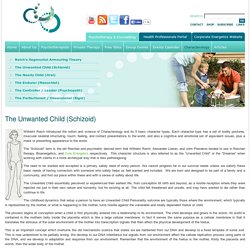
Each character type has a set of bodily postures, muscular skeletal structuring, touch, feeling, and contact presentations to the world, and also a cognitive and emotional set of equivalent issues, plus a mask or presenting appearance to the world. The “Schizoid” term is the old Reichan and psychiatric derived term that Wilhelm Reich, Alexander Lowan, and John Pierrakos tended to use in Reichan therapy, Bioenergetics, and Core Energetics respectively. This character structure is also referred to as the “Unwanted Child” or the “Dreamer” when working with clients in a more archetypal way that is less pathologising.
The need to be wanted and accepted is a primary safety need of every person. We cannot progress far in our survival needs unless we satisfy these basic needs of having connection with someone who safely helps us feel wanted and included. References. Energetics Institute. Wilhelm Reich introduced the notion and science of Characterology and its 5 basic character types.
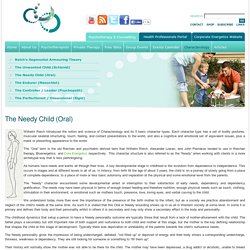
Each character type has a set of bodily postures, muscular skeletal structuring, touch, feeling, and contact presentations to the world, and also a cognitive and emotional set of equivalent issues, plus a mask or presenting appearance to the world. The “Oral” term is the old Reichan and psychiatric derived term that Wilhelm Reich, Alexander Lowan, and John Pierrakos tended to use in Reichan therapy, Bioenergetics, and Core Energetics respectively. This character structure is also referred to as the “Needy” when working with clients in a more archetypal way that is less pathologising. All humans have needs and wants all through their lives. A key developmental stage in childhood is the evolution from dependence to independence.
The “Needy” character encountered some developmental arrest or interruption to their satisfaction of early needs, dependency and dependency gratification. References. The Endurer (Masochist) Wilhelm Reich introduced the notion and science of Characterology and its 5 basic character types.
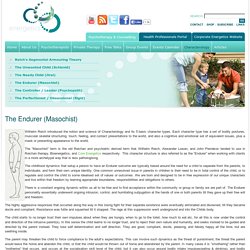
Each character type has a set of bodily postures, muscular skeletal structuring, touch, feeling, and contact presentations to the world, and also a cognitive and emotional set of equivalent issues, plus a mask or presenting appearance to the world. The “Masochist” term is the old Reichan and psychiatric derived term that Wilhelm Reich, Alexander Lowan, and John Pierrakos tended to use in Reichan therapy, Bioenergetics, and Core Energetics respectively. This character structure is also referred to as the “Endurer” when working with clients in a more archetypal way that is less pathologising.
The childhood dynamics that setup a person to have an Endurer outcome are typically based around the need for a child to separate from the parents, to individuate, and form their own unique identity. The parent may threaten the child to force compliance to the adult’s expectations. References. The Controller / Leader (Psychopath) Wilhelm Reich introduced the notion and science of Characterology and its 5 basic character types.

Each character type has a set of bodily postures, muscular skeletal structuring, touch, feeling, and contact presentations to the world, and also a cognitive and emotional set of equivalent issues, plus a mask or presenting appearance to the world. The “Psychopathic” term is the old Reichan and psychiatric derived term that Wilhelm Reich, Alexander Lowan, and John Pierrakos tended to use in Reichan therapy, Bioenergetics, and Core Energetics respectively. This character structure is also referred to as the “Controller/Leader” when working with clients in a more archetypal way that is less pathologising. The childhood dynamics that setup a person to have a Controller/leader outcome are typically those that follow, but other dynamics can also lead to this same outcome. The basic need of every person is to be healthily esteemed. References. The Perfectionist / Obsessional (Rigid) Wilhelm Reich introduced the notion and science of Characterology and its 5 basic character types.
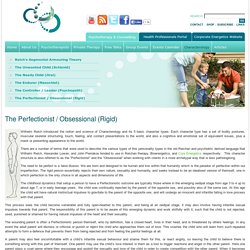
Each character type has a set of bodily postures, muscular skeletal structuring, touch, feeling, and contact presentations to the world, and also a cognitive and emotional set of equivalent issues, plus a mask or presenting appearance to the world. There are a number of terms that were used to describe the various types of this personality types in the old Reichan and psychiatric derived language that Wilhelm Reich, Alexander Lowan, and John Pierrakos tended to use in Reichan therapy, Bioenergetics, and Core Energetics respectively.
This character structure is also referred to as the “Perfectionist” and the “Obsessional” when working with clients in a more archetypal way that is less pathologising. The need to be perfect is a false illusion. We are born and designed to be human and live within that humanity which is the paradox of perfection within our imperfection. References. Which of These Five Dysfunctional Personality Types Best Describes You? Photo Credit: Shutterstock.com Many animals rely heavily on instinct when it comes to raising their young.

Of course, I will never know if a mama bear is concerned about feeding her children farmed salmon. I don’t think mama monkeys debate wearing their offspring vs. pushing them in strollers. And I am pretty sure that when a mama lizard eats her baby she isn’t contemplating, “should I be doing this? " but rather just devours it because infant flesh is delicious. Our capacity to analyze, reason and project consequences into the future means parenting is a very complex process for human beings. When it comes to our personalities, there will always be the influence of nature and nurture. Controversial psychoanalyst Wilhelm Reich developed the idea of Characterology, which essentially categorizes people into five groups stemming from experiences in our nuclear families. 1. 2. 3. 4.
Personality Types. New Content The Primary Passions [05.15.03] Long & Sedley (pp. 410-11) translate Strobaeus [speaking for the Stoics]: "[O]ne must suppose that some passions are primary and dominant, while others have these as their reference.
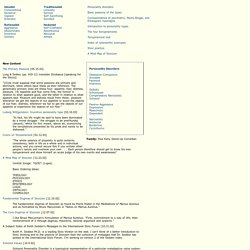
The generically primary ones are these four: appetite, fear, distress, pleasure. (4) Appetite and fear come first, the former in relation to what appears good, and the latter in relation to what appears bad. Pleasure and distress result from these: pleasure whenever we get the objects of our appetite or avoid the objects of our fear; distress, whenever we fail to get the objects of our appetite or experience the objects of our fear. " Ludwig Wittgenstein: Inventive personality type [03.10.03] "In fact, his life might be said to have been dominated by a moral struggle - the struggle to be anst‰ndig (decent), which for him meant, above all, overcoming the temptations presented by his pride and vanity to be dishonest.
" Cicero on Temperament [01.12.03] Keith H. Neuroticism. Emotional stability[edit] At the opposite end of the spectrum, individuals who score low in neuroticism are more emotionally stable and less reactive to stress.
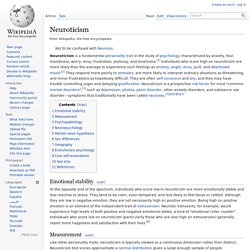
They tend to be calm, even-tempered, and less likely to feel tense or rattled. Although they are low in negative emotion, they are not necessarily high on positive emotion. Being high on positive emotion is an element of the independent trait of extraversion. Neurotic extraverts, for example, would experience high levels of both positive and negative emotional states, a kind of "emotional roller coaster".
Measurement[edit] Like other personality traits, neuroticism is typically viewed as a continuous dimension rather than distinct. Extent of neuroticism is generally assessed using self-report measures, although peer-reports and third-party observation can also be used. Statement measures tend to comprise more words, and hence consume more research instrument space, than lexical measures. Psychopathology[edit] Neuropsychology[edit]